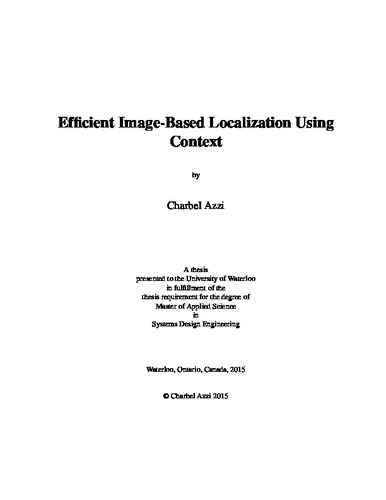UWSpace will be migrating to a new version of its software from July 29th to August 1st. UWSpace will be offline for all UW community members during this time.
Efficient Image-Based Localization Using Context
| dc.contributor.author | Azzi, Charbel | |
| dc.date.accessioned | 2015-12-22 16:51:28 (GMT) | |
| dc.date.available | 2015-12-22 16:51:28 (GMT) | |
| dc.date.issued | 2015-12-22 | |
| dc.date.submitted | 2015-12-21 | |
| dc.identifier.uri | http://hdl.handle.net/10012/10078 | |
| dc.description.abstract | Image-Based Localization (IBL) is the problem of computing the position and orientation of a camera with respect to a geometric representation of the scene. A fundamental building block of IBL is searching the space of a saved 3D representation of the scene for correspondences to a query image. The robustness and accuracy of the IBL approaches in the literature are not objective and quantifiable. First, this thesis presents a detailed description and study of three different 3D modeling packages based on SFM to reconstruct a 3D map of an environment. The packages tested are VSFM, Bundler and PTAM. The objective is to assess the mapping ability of each of the techniques and choose the best one to use for reconstructing the IBL 3D map. The study results show that image matching which is the bottleneck of SFM, SLAM and IBL plays the major role in favour of VSFM. This will result in using wrong matches in building the 3D map. It is crucial for IBL to choose the software that provides the best quality of points, \textit{i.e.} the largest number of correct 3D points. For this reason, VSFM will be chosen to reconstruct the 3D maps for IBL. Second, this work presents a comparative study of the main approaches, namely Brute Force Matching, Tree-Based Approach, Embedded Ferns Classification, ACG Localizer, Keyframe Approach, Decision Forest, Worldwide Pose Estimation and MPEG Search Space Reduction. The objective of the comparative analysis was to first uncover the specifics of each of these techniques and thereby understand the advantages and disadvantages of each of them. The testing was performed on Dubrovnik Dataset where the localization is determined with respect to a 3D cloud map which was computed using a Structure-from-Motion approach. The study results show that the current state of the art IBL solutions still face challenges in search space reduction, feature matching, clustering, and the quality of the solution is not consistent across all query images. Third, this work addresses the search space problem in order to solve the IBL problem. The Gist-based Search Space Reduction (GSSR), an efficient alternative to the available search space solutions, is proposed. It relies on GIST descriptors to considerably reduce search space and computational time, while at the same exceeding the state of the art in localization accuracy. Experiments on the 7 scenes datasets of Microsoft Research reveal considerable speedups for GSSR versus tree-based approaches, reaching a 4 times faster speed for the Heads dataset, and reducing the search space by an average of 92% while maintaining a better accuracy. | en |
| dc.language.iso | en | en |
| dc.publisher | University of Waterloo | en |
| dc.subject | Thesis | en |
| dc.subject | Dissertation | en |
| dc.subject | Image-Based Localization | en |
| dc.title | Efficient Image-Based Localization Using Context | en |
| dc.type | Master Thesis | en |
| dc.pending | false | |
| uws-etd.degree.department | Systems Design Engineering | en |
| uws-etd.degree.discipline | System Design Engineering | en |
| uws-etd.degree.grantor | University of Waterloo | en |
| uws-etd.degree | Master of Applied Science | en |
| uws.contributor.advisor | Zelek, John | |
| uws.contributor.affiliation1 | Faculty of Engineering | en |
| uws.published.city | Waterloo | en |
| uws.published.country | Canada | en |
| uws.published.province | Ontario | en |
| uws.typeOfResource | Text | en |
| uws.peerReviewStatus | Unreviewed | en |
| uws.scholarLevel | Graduate | en |

